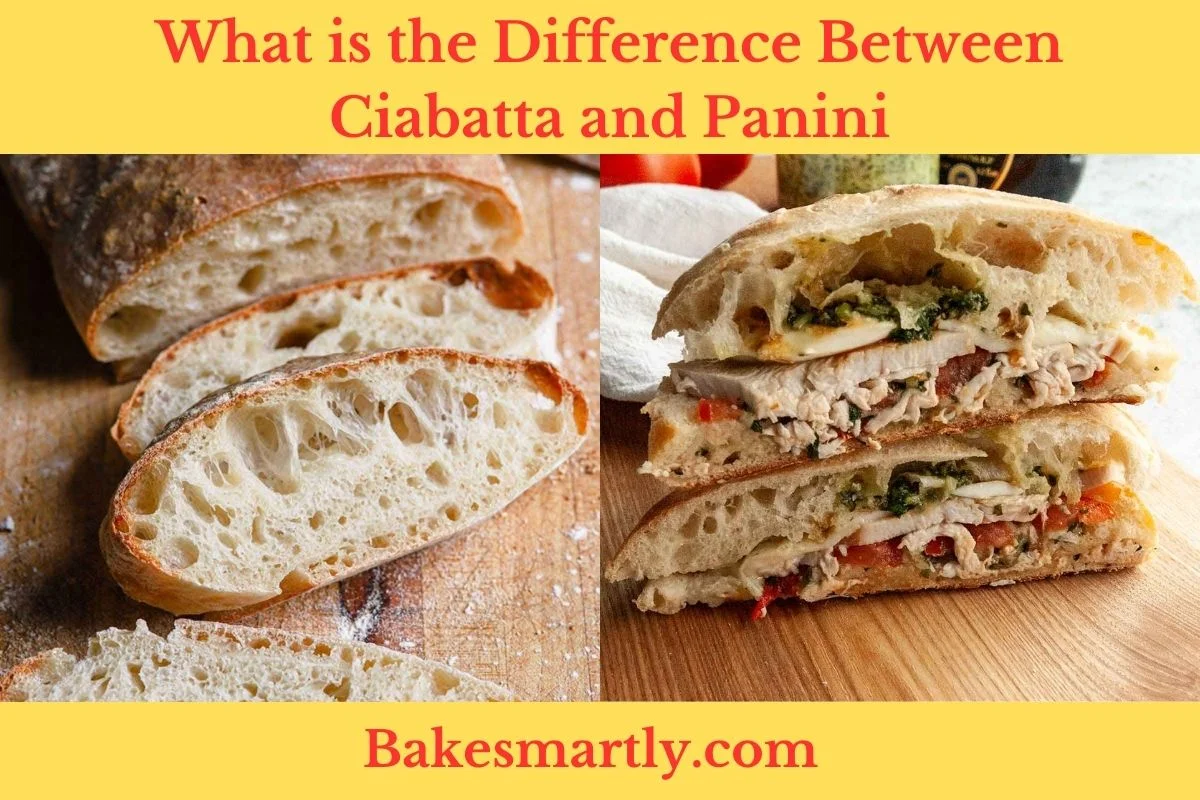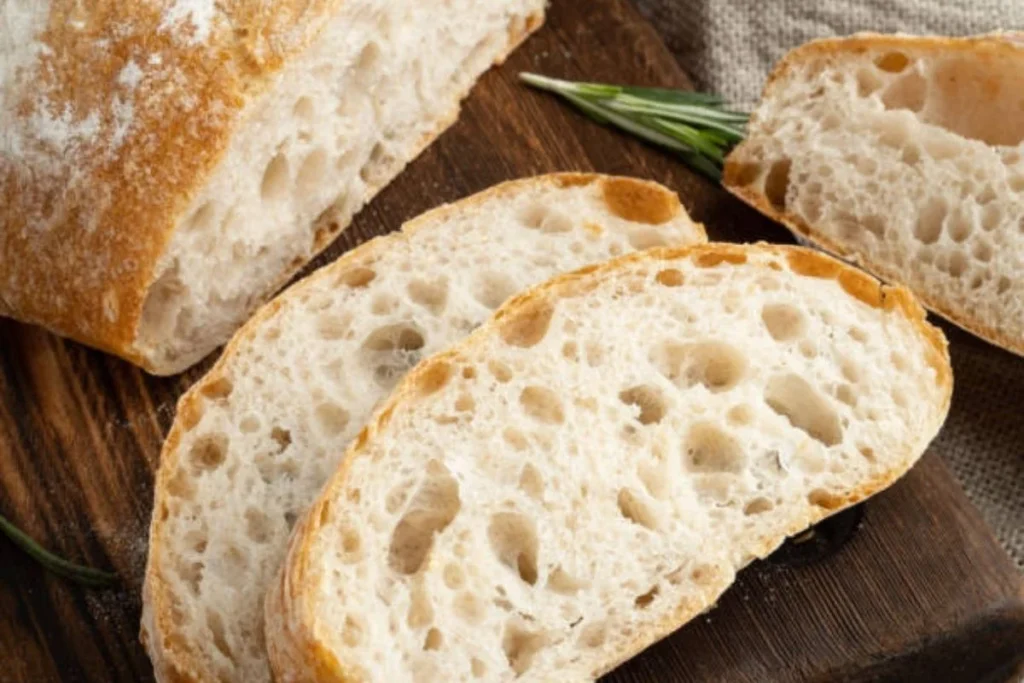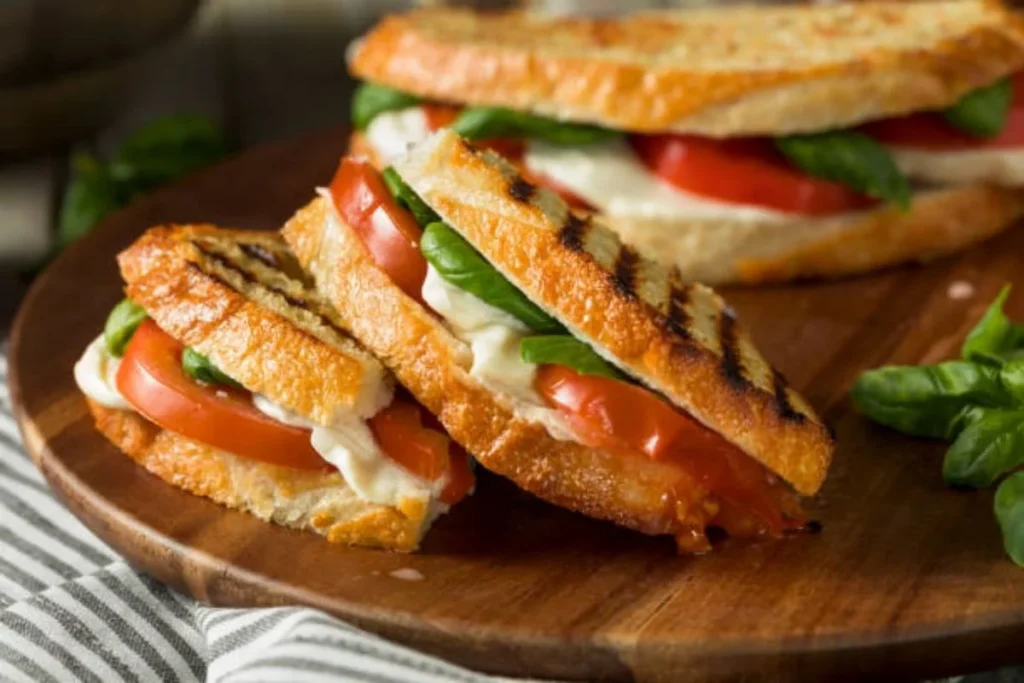
What is the Difference Between Ciabatta and Panini
Welcome to the ultimate battle of the Italian breads: ciabatta vs. panini! These two breads each have their own special qualities and flavors that make them popular choices for sandwiches.
In this blog, we’ll explore the tasty contrasts between ciabatta and panini, revealing what makes them so loved.
Table of Contents
ToggleIs Ciabatta a Panini?
No, Ciabatta and Panini aren’t the same. Ciabatta is this Italian bread that’s light and fluffy, with an uneven shape. It’s made with dough that’s got a lot of water in it, so the inside’s chewy and the outside’s crispy.
On the other hand, a Panini, that’s a grilled sandwich, usually made with Italian bread like Ciabatta or a baguette. The word ‘Panini’ actually describes how it’s cooked – you squash it down and grill it so it’s crispy on the outside and all gooey and warm on the inside.
So, you can use Ciabatta to make a Panini, but not every Ciabatta sandwich is a Panini because Panini’s all about how it’s cooked.”
Ingredients and Preparation Methods of Ciabatta vs Panini
The difference between Ciabatta and Panini isn’t just about how they look when they’re done cooking. It also comes down to what ingredients are used and how they’re made to whip up these tasty Italian treats.
Let’s explore the unique components and preparation methods that contribute to the individual character of these two.

Ciabatta
Ciabatta bread, which means “slipper” in Italian, is a rustic loaf with a long shape and a crumb that’s full of holes. It was invented by Italian baker Arnaldo Cavallari in the 1980s when he wanted to make something similar to the French baguette. The result was Ciabatta, known for its airy texture, chewiness, and slightly tangy taste.
Ciabatta bread usually includes flour, water, yeast, and salt. Some recipes might add a bit of olive oil for flavor and texture. The dough is pretty wet because it has more water compared to flour.
Making Ciabatta isn’t too hard, but it takes time and attention to detail. You mix the dough to make it stretchy and let it sit to rise, so the yeast can do its job. Unlike some other bread, Ciabatta doesn’t need much kneading, which helps give it its unique holey texture.
After the dough rises, you shape it into long loaves and bake them at a high temperature. This gives the bread a crispy crust, a chewy inside, and a taste that goes great with olive oil, balsamic vinegar, or pesto.
Panini
Panini isn’t a type of bread; it’s a grilled or pressed sandwich made with Italian bread. You can use different types of bread, but some work better for grilling without getting too crunchy.
You can use various types of bread for Panini, including Ciabatta, but it’s not limited to just one kind. Common choices include baguettes, focaccia, or regular Italian white or wheat bread. The key to a good Panini is choosing tasty fillings and getting the grilling or pressing just right.
To make a Panini, you stack yummy ingredients between two slices of bread and then grill or press the sandwich. This makes the outside crispy while blending the flavors of the filling. Traditional Panini often have cured meats, cheeses, veggies, and condiments like pesto or aioli.
Panini presses or grills with ridges are used to get those classic grill marks and press the sandwich, making it deliciously compact and full of flavor. The heat from grilling not only warms up the filling but also gives the bread a nice crunch.

Key Difference Between Ciabatta and Panini
Now that we’ve explored the individual characteristics of Ciabatta and Panini, let’s delve into the key differences that distinguish these two Italian culinary delights:
Form and Structure
Ciabatta: Known for its elongated shape and irregular crumb structure, Ciabatta has a rustic appearance. The open texture allows for air pockets, giving it a chewy and airy quality.
Panini: Panini, on the other hand, refers to the sandwich itself rather than the bread. The bread used for Panini can vary, but it is often chosen for its ability to withstand grilling and create a crisp exterior.
Bread Composition
Ciabatta: Made from a high-hydration dough, Ciabatta has a wet and sticky consistency. The basic ingredients include flour, water, yeast, salt, and sometimes a touch of olive oil.
Panini: The bread used for Panini can be diverse, ranging from Ciabatta to baguettes or traditional Italian bread. Panini’s focus is on the filling ingredients rather than the specific bread used.
Preparation Method
Ciabatta: Ciabatta involves minimal kneading and a longer fermentation period to develop its characteristic flavor and texture. The loaves are shaped and baked at high temperatures to achieve a crispy crust.
Panini: Panini preparation involves assembling a sandwich with a variety of ingredients, typically featuring meats, cheeses, vegetables, and condiments. The sandwich is then grilled or pressed to create a cohesive and flavorful result.
Serving Style
Ciabatta: Typically served as a standalone bread, Ciabatta is often sliced and enjoyed with olive oil, balsamic vinegar, or used as a base for bruschetta.
Panini: Served as a pressed or grilled sandwich, Panini is a complete meal featuring a combination of flavors and textures within the bread.

Popular variations of Ciabatta and Panini
Now let’s explore some popular variations that make these favorite dishes even better.
Variations of Ciabatta
- Rosemary Ciabatta: This type of ciabatta has a lovely smell and taste of rosemary, adding a nice herbal touch to the original recipe. The rosemary gives the bread an extra kick of flavor.
- Olive Ciabatta: This version brings in the delicious salty flavor of olives by mixing chopped or whole olives into the dough. The combo of the olives and the chewy ciabatta texture makes for a unique and tasty treat.
- Whole Wheat Ciabatta: If you’re looking for a healthier option, this variation swaps out white flour for whole wheat flour. It still has that airy texture, but with a nuttier taste and added nutrition.
- Cheese and Herb Ciabatta: Taking ciabatta up a notch, this version mixes in grated cheese and herbs like thyme or oregano. The result is a savory, aromatic bread that goes great with any meal or as a snack on its own.
Variations of Panini
- Mediterranean Veggie Panini: A healthy and tasty choice, this version includes grilled veggies such as zucchini, eggplant, bell peppers, and feta cheese, all packed into a crunchy bread.
- Turkey and Cranberry Panini: Great for a festive twist, this Panini brings together roasted turkey, cranberry sauce, and brie cheese, mixing savory and sweet flavors.
- Caprese Panini: Taking cues from the classic Caprese salad, this Panini features fresh mozzarella, juicy tomatoes, basil leaves, and a drizzle of balsamic glaze, all pressed for an Italian taste.
- Spicy Chicken and Avocado Panini: For those who like it hot, this Panini has grilled spicy chicken, creamy avocado slices, pepper jack cheese, and a touch of spicy mayo, giving a perfect blend of spiciness and creaminess.
What is the Best Bread For a Panini?
The best bread for a panini is one that can hold up well to pressing and grilling, resulting in a crispy exterior while maintaining a tender interior. Here are some popular choices:
- Ciabatta: This Italian bread is known for its porous texture and rustic crust, making it an excellent choice for panini. It crisps up nicely on the outside while staying soft on the inside.
- Sourdough: Sourdough bread offers a tangy flavor and a sturdy structure, making it a great option for panini. Look for a good-quality sourdough with a robust crust.
- Baguette: A classic French baguette can work well for a panini, providing a thin, crispy crust and a soft interior. It’s important to choose a baguette that is not too airy to prevent it from becoming too crispy.
- Focaccia: Focaccia’s flat and dimpled surface makes it an interesting choice for panini. It has a soft and chewy texture that can hold up to grilling, and the herb-infused varieties add extra flavor.
- Panini Bread: Some specialty stores offer bread labeled specifically as “panini bread.” These are often made with a combination of white and whole wheat flour, designed to withstand the heat of a panini press.

How to Make a Panini with Ciabatta?
Making a Panini with Ciabatta is a delicious and straightforward process. Here’s a simple recipe for you:
Ingredients:
- Ciabatta bread (sliced)
- 1/2 pound of your preferred deli meats (turkey, ham, chicken, etc.)
- 1/2 pound of cheese (Swiss, mozzarella, cheddar, etc.)
- Condiments (mustard, mayonnaise, pesto, etc.)
- 1 cup of fresh vegetables (lettuce, tomatoes, red onions, etc.)
- Olive oil or butter for brushing
Step-by-Step Instructions
Begin by preheating your Panini press. If you don’t have one, a stovetop grill pan or a regular pan can be used; simply preheat it to medium-high heat.
Next, prepare your ingredients. Slice the Ciabatta bread to your desired thickness, with thin slices working well for quicker and more even grilling. Lay out your deli meats, cheese, and fresh vegetables for easy assembly.
Now, assemble the Panini. Start with one slice of Ciabatta and layer on your preferred deli meats, cheese, condiments, and fresh vegetables. The order can be tailored to personal preference, but placing cheese next to the bread helps hold the ingredients together. Top with the second slice of Ciabatta to create a sandwich.
Lightly brush the outer sides of the Ciabatta with olive oil or melted butter to enhance the crispiness of the bread during grilling.
Proceed to grill the Panini. If using a Panini press, place the sandwich on the preheated press, close the lid, and grill for 3-5 minutes or until the bread is golden brown and the cheese is melted. If using a stovetop grill pan or a regular pan, place the sandwich on the hot surface, press down with a spatula, and cook for 2-3 minutes on each side or until the bread is toasted, and the cheese is melted.
Check for doneness by carefully opening the Panini press or lifting the sandwich with a spatula. The bread should be golden and crispy, while the cheese should be gooey and melted.
Once done, remove the Ciabatta Panini from the grill or press. Allow it to cool for a minute before slicing, letting the cheese set slightly for easier cutting. Serve your Panini with a side of fresh greens, pickles, or your favorite dipping sauce.
To add a creative touch, feel free to experiment with different combinations of meats, cheeses, and condiments. Consider unique additions such as roasted red peppers, caramelized onions, or a spread of fig jam for an extra layer of flavor. Enjoy the culinary adventure!
Difference Between Ciabatta and Panini | Conclusion
In the big world of Italian food, Ciabatta and Panini stand out. They each bring something special to the table. Ciabatta is all rustic and chewy, a favorite bread that people love all around the globe. And then there’s Panini, that grilled Italian sandwich. It’s like a canvas for all sorts of tasty fillings.
Whether you’re keeping it simple with Ciabatta and olive oil or going all out with a loaded Panini, these Italian treats always hit the spot. They show off the skill behind making bread delicious.
So, next time you can’t decide between these two yummy options, just remember they’re not just bread—they’re a whole experience. One’s a rustic loaf, the other’s a grilled masterpiece of flavor.
Lindsey Mackenzie
About me
Hi there! I’m Lindsey Mackenzie, the founder of Bake Smartly. Baking has been my passion since childhood, growing up in my father’s bakery. With Bake Smartly, I’m excited to share my love for all things sweet and savory. Join me on this delicious journey as we whip up scrumptious treats and sprinkle joy into every bite!






